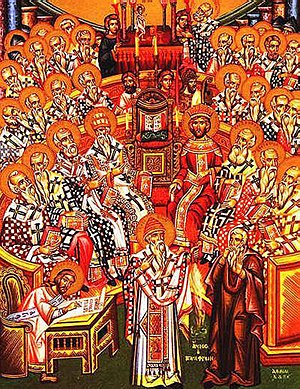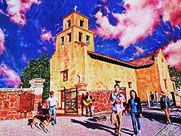Christian Epoch
Religious Riots
Christianity began with the shedding of Christ's blood. It grew with the blood of its early martyrs. After the Roman Empire turned towards Christianity and against ancient polytheistic beliefs, the blood would continue to flow. No longer that of martyrs, the stoning, beatings and torture would turn to street fights and full-blown riots between competing, often conflicting, sects within Christianity. By the fourth century CE, the Roman Empire was overrun with Christians. The vast gulf in belief and tolerance between Christian sects to then would make any Christian discrepancies today insignificant by comparison..JPG/400px-0_Constantinus_I_-_Palazzo_dei_Conservatori_(2).JPG) |
| Constantine the Great |
Initial Consolidation
Emperor Constantine was forced to come to grips with the issue and subsequently legalized Christianity with his Edict of Milan in 313 CE However, legalization only brought the division to a head and by 325 CE Constantine ordered all Christian bishops to a small town in ancient Byzantium (known as Turkey today), called Nicaea. Constantine placed himself at the head of what has since been referred to as the Council of Nicaea, mandating the bishops to resolve the chaos by establishing a singular canon of beliefs, beginning with scripture. The Bishop of Rome, Pope Sylvester I, had two legates attend and approved the council's decisions in his stead.Scripture and Word-of-Mouth
From the outset of the Council, the central point of consternation was a lack authentic documentation. No written accounts had survived from the time of Christ because during the Apostolic Age the word of Christ had been spread through Sacred Oral Tradition. The earliest know fragments of gospels scripture date to more than 150 years after Christ's death. Consequently, church documentation gathered for the council from across the empire was both conflicting and, for the most part, relatively recent. This was no accident. Very few people could read during the time of Christ and even fewer could write. The literacy rate of Roman citizens (the most educated class) is today considered to have been no more than 10%. Moreover, most schooled Romans were only trained to read. In a poor, sparsely populated fishing village like Nazareth, the home of the Apostles and the birthplace of Christ's mission, literary schooling of any sort was likely non-existent. Even if scribes had been hired and a literate public had been available to read the developing gospels, countless copies would have been required for all the advancing parishes of this rapidly growing phenomenon.Rapid Growth and Mixed Harvest
Add to this lack of documentation the transmutation of religious prose occurring since Christ's time through regionally adapted translation, bias retellings and re-transcription. Subsequently, by Constantine's time, the Gospels (Greek for "good news") had undergone considerable development and change.
The original Apostolic Church was lead by Christ's immediate followers. It lasted about 50 years and, like Christ, his immediate followers were observing Jews. They only departed from the Law of Moses by believing Christ to be their promised Messiah. Consequently, the spread of the faith was slow at first because this rebel Judaic belief was confined to those of the Jewish faith. Any gentile man wanting to join would have to first be circumcised before being accepted as a Christian, something that hardly caused admission lines to grow.
The original Apostolic Church was lead by Christ's immediate followers. It lasted about 50 years and, like Christ, his immediate followers were observing Jews. They only departed from the Law of Moses by believing Christ to be their promised Messiah. Consequently, the spread of the faith was slow at first because this rebel Judaic belief was confined to those of the Jewish faith. Any gentile man wanting to join would have to first be circumcised before being accepted as a Christian, something that hardly caused admission lines to grow.
Enter Paul
It wasn't until Saul of Tarsus, renamed Paul the Apostle, embraced Christianity that the religion began to flourish outside the Jewish faith. Paul made it his personal mission to convert gentiles, often times forcing confrontations with Peter, the acting head of the Christianity. Paul was likely responsible for spreading the word further than any missionary in the history of the faith.
Subsequently, Paul's form of Christianity, one free of Judaic confines, would spread thousands of miles in various directions. It would take hold to the West in Greece, Syria, Egypt and even further East towards the orient. Consequently, along with its spread, translations and cultural interpretations occurred with each new audience. With every hundred miles, over each passing month, the gospel would undergo some type of reformulation. This would often times occur far out of earshot of Paul or any of the immediate disciples of Christ.
To Paul's credit, he traveled with Luke the Evangelist, a physician, who was fully literate. Between the two of them Paul was able to keep tabs on his flocks through letters, when they fell into the hands of a literate follower. These letters are today known as the Pauline Epistles. Still, as the missions progressed, there would continue to be illiterate followers of Paul and the other Apostles, with no option other than to continue the Sacred Tradition as an Oral Tradition which would lead to mixed and varied retellings or translations of the gospel.
Uniting Force
To Paul's credit, he traveled with Luke the Evangelist, a physician, who was fully literate. Between the two of them Paul was able to keep tabs on his flocks through letters, when they fell into the hands of a literate follower. These letters are today known as the Pauline Epistles. Still, as the missions progressed, there would continue to be illiterate followers of Paul and the other Apostles, with no option other than to continue the Sacred Tradition as an Oral Tradition which would lead to mixed and varied retellings or translations of the gospel.
Uniting Force
Identifying Division
Continuous provincial retellings would eventually force edits, extensions and new manifestations of the gospel. More often than not, new Christians would retain and intermingle portions of previous non-Christian beliefs into their retellings for the sake of cultural context. |
| Council of Nicaea |
- Apollinarism
- Arianism
- Docetism
- Eutychianism
- Gnosticism
- Monarchianism
- Montanism
- Nestorianism
- Pelagianism
The bishops gathered at Nicaea commenced to assemble all accounts of what is today referred to as the New Testament. Oral and written doctrine was reviewed and judged for authenticity, credibility and consistency of message. The resulting goal was to begin the process to establish a single, absolute and final canon of faith (a process that would take centuries). Once accomplished, singularity was to be enforced by formally stamping out all teachings of conflicting and sometimes fantastic accounts of the life of Christ (i.e.: The Gnostic Gospel of Thomas).
Heresy and Church Law
Once the Council reached a level of mutual agreement, formal notions of heresy could then be firmly established and made law, which the church and the emperor could then pursue and expunge. This would, of course, mean more bloodshed, but at least the persecution was to be narrowed down and religious rioting eliminated, if not greatly reduced. Religious opinion was no longer to be a point of argument, debate or street tussles. Heresy would eventually become a serious crime and would be prosecuted from the head of the church, even the emperor’s throne. Indictments of heresy would most likely result in death if not torture along the way. |
| The Battle of Milvian Bridge |
Constantine and the Cross
At the Battle of Milvian Bridge, some dozen years before the Council of Nicaea, Emperor Constantine claimed to see the Chi Rho or Staurogram cross (Lactantius is unclear) aloft in the clouds while preparing to engage opposing Roman troops. Conveniently, this sighting and the painting of the symbol on his soldier's shields would lift the morale of his (by then) mostly Christian troops and carry those forces to overwhelming victory. Though Constantine was not baptized until just before his death, the sighting and subsequent victory would provide him an almost saintly status, allowing a now converted Emperor to call the Council of Nicaea and be seated at its head or Pontifex Maximus.
Commentary
As Paul gets credit for spreading Christianity, Emperor Constantine likely did more to shape church canon than any pope. Had the Emperor not come along, its hard to imagine what the fate of that still young, greatly divided and rapidly growing faith would have been. For the faithful, his involvement may be considered a form of divine intervention. On a more secular level, the reasons for Constantine’s involvement were probably selfish. He could tell which direction the preverbal wind was blowing and was no doubt impressed with Christian fervor. Ending the bickering among Christian sects would only strengthen the empire while promoting much needed loyalty to the newly established Eastern throne, a loyalty that would survive with the ancient Byzantine city of Antioch remaining the seat of Christian canon until the Great Schism of 1054 CE.Go to: Chapter 2) Iconic Fulfillment of the Judaic Messiah
Got Feedback?
Comments? Questions? Corrections? Any feedback at all? Just click on the comments box at the bottom of this page and enter your thoughts. All comments are welcome.
Santuario de Guadalupe, the oil painting by Tom Mallon. This 42" x 22" canvas is the latest addition to the Santa Fe Portrait Series. The Santuario is the oldest shrine to Our Lady of Guadalupe in the US.
Visit this later update by CLICKING HERE
Shostakovich and Cultural Snobbery, Could anyone survive Stalin's Purges, compose a large body, write for himself and the masses while producing constantly great work?
Visit this later update by CLICKING HERE
Also of interest…
Tom Mallon's website "MallonArt". This website will provide you with links to all his paintings, drawings and other artwork portfolios, including the ongoing series entitled the Santa Fe Portrait.
Visit this later update by CLICKING HERE
Comments? Questions? Corrections? Any feedback at all? Just click on the comments box at the bottom of this page and enter your thoughts. All comments are welcome.
Santuario de Guadalupe, the oil painting by Tom Mallon. This 42" x 22" canvas is the latest addition to the Santa Fe Portrait Series. The Santuario is the oldest shrine to Our Lady of Guadalupe in the US.
Visit this later update by CLICKING HERE
Shostakovich and Cultural Snobbery, Could anyone survive Stalin's Purges, compose a large body, write for himself and the masses while producing constantly great work?
Visit this later update by CLICKING HERE
Tom Mallon's website "MallonArt". This website will provide you with links to all his paintings, drawings and other artwork portfolios, including the ongoing series entitled the Santa Fe Portrait.
Visit this later update by CLICKING HERE





